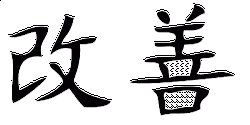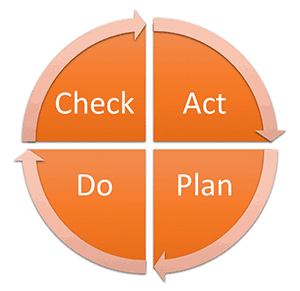The Kaizen Approach to Workflow Automation
By Mike Raia ![]() | Published January 16, 2018
| Published January 16, 2018
Enabling the Kaizen approach with workflow automation can increase productivity, enhance efficiency, and reduce waste. It can also help you eliminate errors, enhance compliance, and improve visibility in your organization. But unlike other workflow automation solutions, Integrify offers versatility and responsiveness, allowing you to make process improvements as you need in order to optimize your business processes and respond in a timely manner to internal and external pressures.
Workflow automation is all about enabling your organization to do more with less — less effort, less time, and less money. However, many companies implement workflow automation for certain processes, proceed to reap the benefits, and leave it at that. Yet in an increasingly competitive global business environment, no organization can afford to let its processes become stagnant. That’s where the Kaizen approach comes in.
What is the Kaizen Approach?

The word “kaizen” means “improvement” in Japanese. It comes from the words “kai,” which means “to change,” and “zen,” which means “good.” In manufacturing and business, the Kaizen approach refers to a system of continuous improvement that occurs by means of incremental change. The term originated in the Japanese manufacturing sector after World War II and became well-known after its adoption by Toyota Motor Corporation. In companies where the Kaizen approach is used, all employees — from workers on the factory floor to CEOs in the board room — are encouraged to regularly make suggestions to improve productivity, effectiveness, quality, and safety while at the same time reducing waste. These improvements, while individually small, can all add up to significant process improvements over time, hence the term “continuous improvement.”
According to MindTools, the Kaizen approach focuses largely on reducing waste, examining factors such as minimizing the time spent on a task, reducing unnecessary movement of items, eliminating defects, avoiding over-processing, and standardizing solutions. As such, it’s not only an effective system for manufacturing, but also for other business environments including HR, accounting, and more.
What’s so important to understand is that the Kaizen approach is not about implementing massive, one-time change based on top-down leadership decisions or the advice of an external consultancy. It’s about fostering a company culture that harnesses the insights of the employees who work with your tools and processes day in, day out in order to improve how you do what you do. And that’s what makes it so powerful.

How the Kaizen Approach Enhances Workflow Automation
So how does the Kaizen approach relate to workflow automation?
Workflow automation is the digital systemization of disparate or manual business processes with the objective of improving efficiency and productivity. For example, in order to produce a report, you might currently use the following process:
One employee extracts the required data from your files and calculates statistics, which are then compiled into a report. The employee sends the report to two higher-ups for approval. They review the report and make any necessary edits manually before sending it back to the employee. The employee collects the revision notes, revises the report, and sends it to the same higher-ups for final approval. Once they’re happy with it, they send it to the executive who requested the report.
Using workflow automation, you could greatly streamline this process. First of all, an employee can use an application to extract data, calculate statistics, and put it all together in a report. He or she can send that report to the same two higher-ups. If they have any edits, they’re incorporated immediately into the file, which can then be sent along to the executive. This entire process requires less effort and less time — and frees employees up to focus on other tasks.
Clearly, workflow automation and the Kaizen approach both have the same goals: to improve efficiency, increase productivity, and eliminate waste. And though workflow automation doesn’t in itself facilitate continuous improvement, it can become very powerful when you pair it with the Kaizen approach. Because when employees use your applications and processes, they’ll automatically notice redundant steps, inefficiencies, and quality issues. When you encourage them to share their findings with you, it can provide you with a clear guide on how to continuously improve your workflow automation so you can work towards optimizing your business processes. Moreover, if you monitor quality and productivity over time, you’ll be able to measure the results of this continuous improvement so you can see which changes are most effective.
Using the Kaizen Approach with Integrify Workflow Automation
 Integrify's solution is particularly well-suited to the Kaizen approach because it allows you to build your own customized workflow and adjust it as you see fit and then iterate. Instead of using some pre-set automated workflow, you can design processes with precisely those steps and actions that you need from the start. After that, continuous improvement can happen in three ways. First, the software itself is continuously being improved by Integrify, so you’ll receive automatic updates and be notified about upgrades. Second, as your people work with your automated workflow, they can give you feedback so you can make enhancements to optimize the process. And third, you can adjust your workflow to respond as needed to internal and external pressures.
Integrify's solution is particularly well-suited to the Kaizen approach because it allows you to build your own customized workflow and adjust it as you see fit and then iterate. Instead of using some pre-set automated workflow, you can design processes with precisely those steps and actions that you need from the start. After that, continuous improvement can happen in three ways. First, the software itself is continuously being improved by Integrify, so you’ll receive automatic updates and be notified about upgrades. Second, as your people work with your automated workflow, they can give you feedback so you can make enhancements to optimize the process. And third, you can adjust your workflow to respond as needed to internal and external pressures.
Consider the following examples of continuous improvement with Integrify solutions:
- You can get quick wins first, and then evolve. When you initially bring in workflow automation, it can generate quick wins in terms of time, effort, and cost savings. Begin by selecting straightforward processes, or automate part of a larger process. Either way, when you show both employees and management how they benefit, it helps bring them onboard for more process automation. Then you can evolve the original processes with an engaged team.
- You can respond to compliance pressures. If you’re in an industry such as financial services or healthcare that has to comply with regulatory, legal, or security requirements, you need to be able to respond to new changes quickly and effectively. Once a process is in place, you can simply adjust and improve those steps that need to be addressed in order to meet requirements. For example, let’s say you’re a healthcare provider with an automated workflow for cybersecurity incident reporting. If federal guidelines for protocols become more rigorous, you can easily include additional required steps in the process.
- You can respond to changes in customer needs and customer experience (CX). Internal and external customer needs evolve over time, sometimes due to trends, other times due to market or competition changes. If your process involves CX (Customer Experience), you can keep optimizing CX by adapting the process. For example, if you have a contact center and you need to reduce the number of agents a caller speaks to before getting the right help, you can introduce logic based on the caller's specific request to immediately route callers to the right department.
- You can adjust to organizational shifts. Organizations expand and merge business units to realize improved performance and opportunity. When this happens, the responsibility for certain tasks often transfers from department to department or from person to person. Because of this, processes need to adapt to the new, improved structure. Integrify solutions allow you to modify task assignments, which in turn ensures a smooth transition. Let’s say that after an expansion, the responsibility for requisitions shifts to a new manager. All you have to do is simply adjust the current task assignment to replace the former manager with the new one.
- You can standardize processes throughout the organization. If your company has a siloed structure, you might be struggling with the fact that each department has its own individual processes and procedures. Integrify allows you to standardize new, improved processes throughout the organization, which creates more transparency and efficiency. As more groups and individuals adopt the new processes, they can continue to offer ideas for improvement.
- You can duplicate successful processes. If you have a process that works well in one department for a certain function, you can duplicate it and adapt it to the needs of another department without having to build one from scratch. This spreads the continuous improvement with less upfront planning and design.
- You can measure improvement. Detailed process reporting enables you to see the results of your adjustments, so continuous improvement becomes a data-driven process. You can measure a variety of KPIs such as:
- Speed of resolution at the individual, departmental, and organizational level: Are tasks being completed faster than before?
- Time to approval: Does it take less time for requests, reports, and requisitions to be approved?
- Request volume: Is a department or the company handling a higher volume of requests?
- Dropped requests: Are the number of dropped requests decreasing?
- Service ratings: Are service ratings by clients and customers going up?
- SLA compliance: Are your suppliers adhering to all specifications of your SLAs?
Conclusion
Enabling the Kaizen approach with workflow automation can increase productivity, enhance efficiency, and reduce waste. It can also help you eliminate errors, enhance compliance, and improve the visibility of your organization. But unlike other workflow automation solutions, Integrify offers versatility and responsiveness, allowing you to make improvements as you need in order to optimize your business processes and respond in a timely manner to internal and external pressures.

Mike Raia
Marketing the world's best workflow automation software and drinking way too much coffee. Connect with me on LinkedIn at https://www.linkedin.com/in/michaelraia/